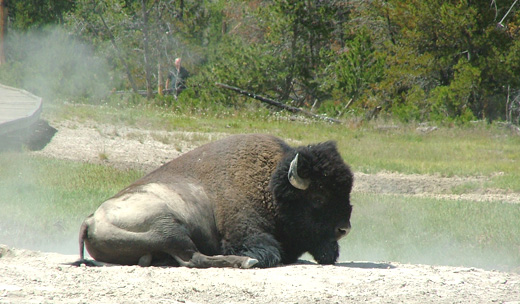
Yellowstone National Park is rounding up bison to be slaughtered, in order to maintain a target population and reduce the spreading of a disease called brucellosis from bison to valuable livestock. The problem with these reasons? They’re not reasons. They’re excuses. And people ranging from Native Americans to animal rights activists are calling Yellowstone out on it.
The American Bison is a species that, like so many others, may soon become a relic of the past due to human interference. After excessive hunting, by 1890 their population had been reduced to 750 and they were on the verge of becoming extinct. Conservation efforts have since saved the animals, pushing their number all the way up to 360,000. But those efforts are now under attack, as corporate and right-wing anti-environment measures become more prominent. Perhaps nowhere has this been more clearly demonstrated than in the case of the current Republican-led effort to truncate and restrict the Endangered Species Act.
As part of a controversial agreement between the park and the Confederated Salish and Kootenai tribes, between 600 and 800 bison will be slaughtered this winter. So far, 20 have been killed. This slaughter is expected to diminish an already-endangered subpopulation of bison located in what is called the Central Interior. Those bison have not yet recovered from a previous park-led slaughter in 2008.
James Holt, a Nez Perce Tribal member, has criticized the other tribes’ decision to agree to take part in Yellowstone’s “population control objective.” He remarked, “It is disheartening to see tribes support these activities. Buffalo were made free and should remain so. It is painful to watch these tribal entities take such an approach when they should [represent] the strongest advocacy and a voice for protection. Slaughter agreements are not the answer.”
The park has argued that tribal concerns over the spreading of brucellosis to their livestock from the mammals is the primary reason for the cull. But Dan Brister, executive director of the Buffalo Field Campaign, a nonprofit organization formed to stop bison slaughter, has disputed that. He also seemed to find their slaughter objective to be cruel and baseless. “The number was politically derived to limit the range of wild buffalo, and has no scientific basis,” he said. “It does not reflect the carrying capacity of the buffalo’s habitat in and around Yellowstone National Park.”
Cattle ranchers, meanwhile, fear that brucellosis from bison wandering away from the park will infect their livestock and cause their cows to abort their calves. However, there has never been a single documented case of a wild bison transmitting the disease to cattle. That the bison are wandering in the first place may be linked to climate change, as the animals increasingly must stray farther from Yellowstone to find winter forage.
Michael Leach, founder and director of nonprofit conservation group Yellowstone Country Guardians, remarked, “There has never been a case of a bison transmitting brucellosis to cattle, but this has not stopped the spending of millions of taxpayer dollars to capture and slaughter them to protect the Brucellosis-free status of the states of Montana and Wyoming. But by February of 2004, Wyoming had already lost that status, Idaho’s status was stripped two years later, and in 2008, Montana followed. But guess what? Elk, not bison, were determined to be the culprits for all of these cases.”
He concluded, “In my opinion, the Yellowstone bison debate is no longer an issue of wildlife management, but one of social justice and moral responsibility. The bison management strategy that has sent 3,800 wild bison to slaughter since 2000 – simply for wandering across an invisible line in search of food – remains stagnant and archaic.” And action on this issue, he stressed, is of the utmost importance. “How we will be evaluated by future generations as wildland stewards will ultimately be measured by how we respond to this challenge.”
Photo: A bison relaxes in Yellowstone National Park. Jan Kronsell/Wikipedia (CC)










